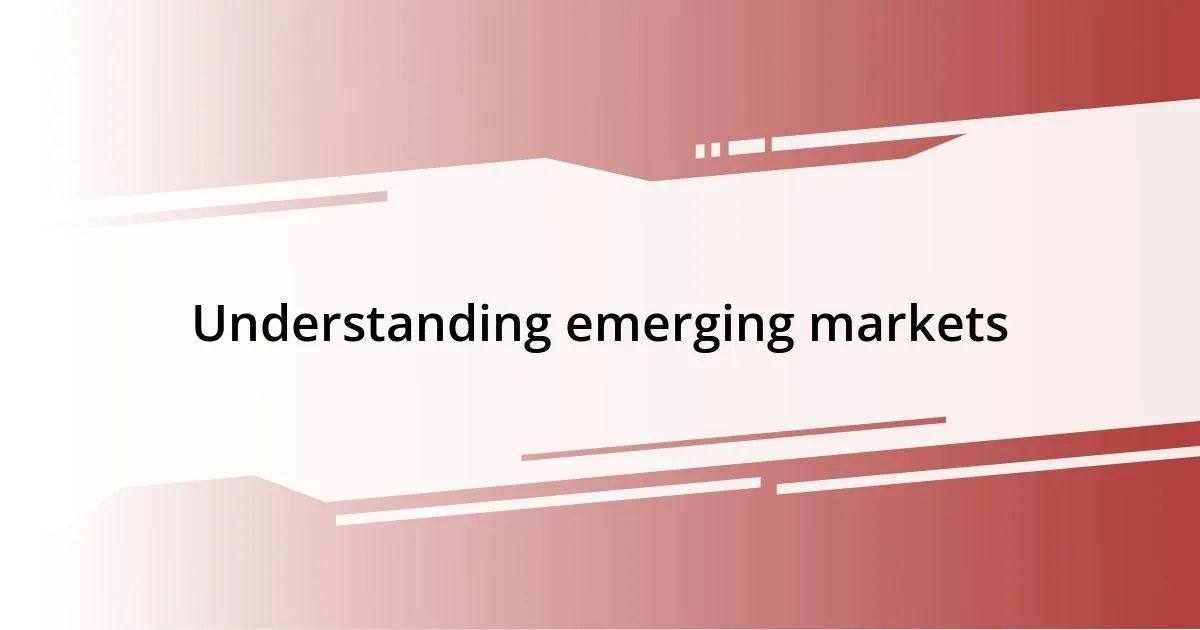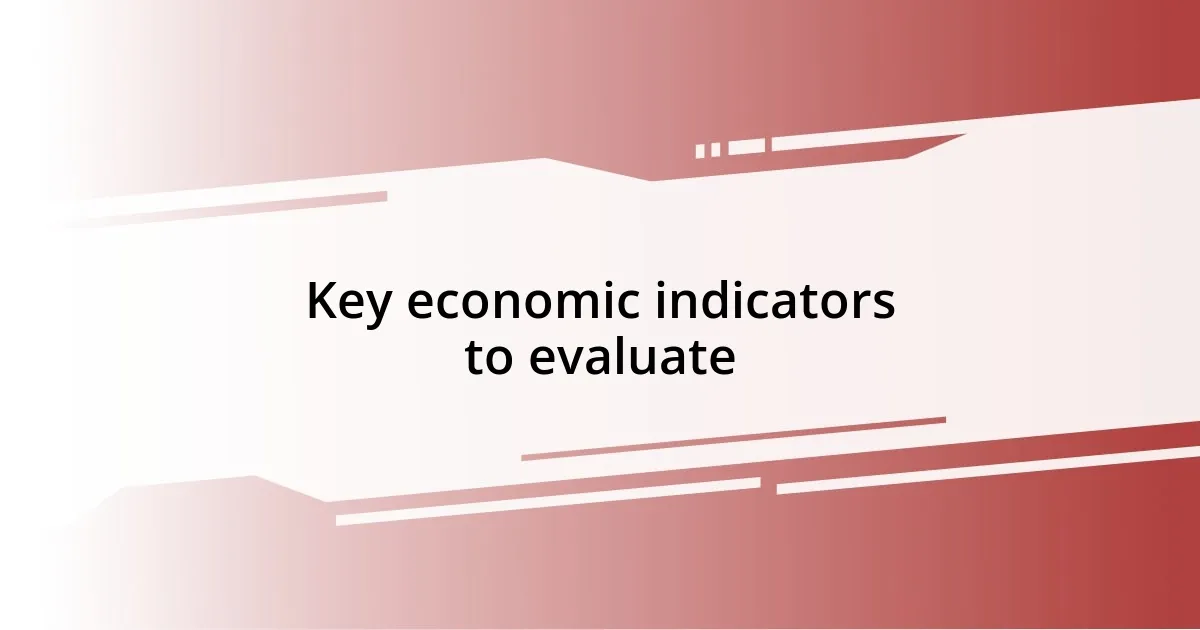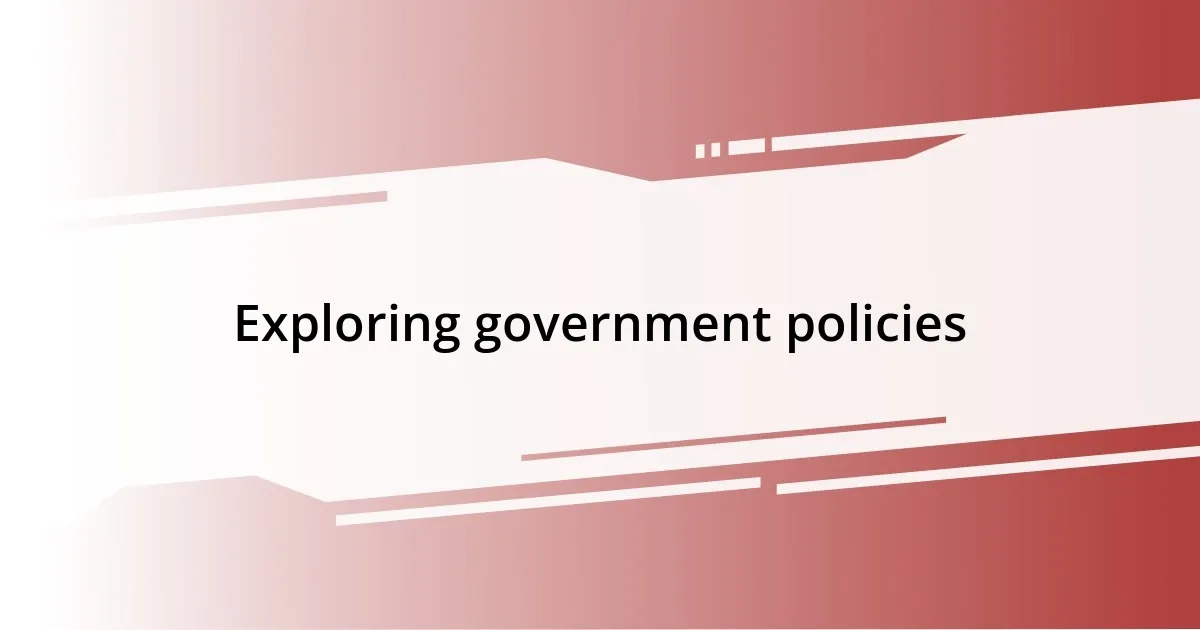Key takeaways:
- Emerging markets exhibit rapid growth and offer unique business opportunities, but also come with inherent risks due to political and economic fluctuations.
- Key economic indicators such as GDP growth, inflation rates, and unemployment rates are crucial for assessing market potential and stability.
- Demographic trends including population growth, age distribution, and urbanization play a significant role in shaping consumer behavior and market demands.
- Strategic entry plans should consider local cultural nuances and potential partnerships, alongside clear objectives for measurement and success.

Understanding emerging markets
Emerging markets are often characterized by their rapid industrialization, economic growth, and improving infrastructure. When I first encountered this concept, I remember feeling a sense of excitement; I saw these markets as potential hubs of innovation and opportunity. Don’t you ever wonder what drives these economies to evolve so quickly?
I’ve witnessed firsthand how consumer behavior shifts in these regions, often leading to unique business opportunities. For instance, during a trip to Southeast Asia, I was struck by the diversity of local markets and how they catered to rapidly changing tastes. This dynamic environment energized me; there was a palpable sense of possibility in the air, as if the ground itself was pulsing with new ideas.
Understanding these markets also means recognizing the risks involved. They can be unpredictable, with fluctuations in politics and economy influencing investment decisions. I recall a late-night conversation with a colleague about our initial foray into an emerging market; we grappled with our fears and excitement. How do we balance the thrill of potential profit with the uncertainty of the unknown? That’s the challenge of engaging with emerging markets—they’re as exhilarating as they are risky.

Key economic indicators to evaluate
When I evaluate emerging markets, I always keep a keen eye on key economic indicators that help paint the broader picture. One of the primary indicators I look at is Gross Domestic Product (GDP) growth. I remember diving deep into a report comparing GDP growth rates across several Latin American countries. The differing rates struck me; it highlighted not just economic performance but the potential for investment. A growing GDP usually signals a rising middle class eager for new products and services—an important insight for anyone looking to make their mark in those regions.
Inflation rates are another critical indicator I consider. High inflation can erode purchasing power and create instability, so I prioritize countries with moderate rates. A few years back, while researching a potential venture into Eastern Europe, I stumbled upon a country experiencing unusually high inflation. My instincts told me to tread carefully. That experience taught me how vital it is to analyze inflation alongside other indicators to gauge market viability.
Lastly, I frequently assess unemployment rates. A high unemployment rate can indicate economic trouble, often translating into a less dynamic consumer base. I recall attending a local market event in an emerging African economy, where the energy was infectious despite higher unemployment rates. People were resilient, showing resourcefulness in the face of adversity. This experience underscored that sometimes, even in challenging economic climates, there are unique opportunities waiting to be discovered.
| Economic Indicator | Importance |
|---|---|
| GDP Growth Rate | Signals economic health and potential for investment |
| Inflation Rate | Affects purchasing power and market stability |
| Unemployment Rate | Indicates labor market health and consumer base strength |

Analyzing demographic trends
When diving into demographic trends, I find it thrilling to see how population characteristics shape the market landscape. I remember a visit to a burgeoning city in India where I encountered the energy of a youthful population. These young individuals were not just consumers; they were trendsetters, deeply engaged with technology and social media. Their unique preferences and aspirations revealed immense potential for innovative products tailored to their specific needs.
Here are some key aspects I analyze when evaluating demographic trends:
- Population Growth Rate: A burgeoning population often signifies a growing market, especially if it’s young and dynamic.
- Age Distribution: Understanding the age demographics helps predict consumer behavior and market demands.
- Urbanization Rate: Rapid urbanization can indicate a shift in consumer spending patterns and infrastructure development.
- Education Levels: Higher educational attainment can signal a readiness for advanced products and services, influencing various sectors.
- Income Distribution: Assessing the spread of income helps identify target markets and purchasing power dynamics.
In my experience, leveraging this demographic data not only helps predict market needs but makes me feel connected to the individuals behind the numbers. Each statistic I encounter tells a story—one that shapes the way we think about opportunity in emerging markets. Just reflecting on those vibrant streets I walked through in India makes me realize how powerful this analysis can be in tapping into new ventures. It’s like being part of an evolving narrative, where each demographic shift hints at what’s to come.

Observing technological advancements
Observing technological advancements is like watching a mosaic come together, each piece revealing a new layer of opportunity. Recently, while researching the tech scene in Southeast Asia, I was blown away by the rapid proliferation of mobile payment systems. It’s fascinating how a simple smartphone can change the way people conduct business and manage finances. I remember a vendor I met who shared how she transitioned from cash-only transactions to digital payments, dramatically increasing her customer base. Isn’t it intriguing how technology can empower small businesses in profound ways?
As I sift through tech trends, I’m always on the lookout for innovation ecosystems. During a visit to a startup hub in a Latin American city, I was struck by the palpable energy. Entrepreneurs were collaborating, sharing ideas in vibrant co-working spaces, and pushing each other to innovate. This environment was not only fostering creativity but also attracting investment from abroad. Have you ever noticed how some regions radiate a strong entrepreneurial spirit? It’s a clear indicator of where emerging markets might thrive.
Another aspect I ponder is how technology can influence social change. I once attended a conference focusing on agritech in East Africa, where young innovators were developing solutions for sustainable farming. The passion in the room was electrifying, with participants genuinely invested in making a difference. It made me wonder: can technology not only drive economic growth but also empower communities? My experience tells me it can, and that’s a critical angle when identifying emerging markets.

Exploring government policies
Examining government policies is a vital step in identifying emerging markets, as they can shape the economic landscape significantly. I recall a conversation with a local entrepreneur in a Sub-Saharan country who explained how recent tax incentives accelerated his business growth. It struck me how governmental support could either ignite or stifle innovation and investment. Are we truly aware of how much influence these policies have on market dynamics?
I’ve noticed that stability and transparency in governance often attract foreign investments. During my time in Eastern Europe, I observed how favorable foreign direct investment (FDI) regulations transformed the business environment. Investors were drawn to regions with clear legal frameworks, creating a ripple effect on local startups. This firsthand observation makes me wonder: what potential lies untapped in countries with evolving regulatory landscapes?
Furthermore, I find it intriguing how social policies can impact market opportunities. While visiting a social enterprise in a developing nation, I was moved by their mission to improve women’s access to education and financial independence. Their success highlighted how policy shifts can unlock new consumer segments and drive economic growth. This experience opened my eyes to the profound connections between government initiatives and emerging market potential. Isn’t it remarkable how governance can create a pathway for societal advancement?

Evaluating market competition
Evaluating market competition is absolutely essential when trying to pinpoint emerging markets. I’ve had moments in bustling marketplaces where I could almost feel the competitive energy. For instance, while exploring a crowded street market in India, I encountered several vendors selling similar products. Each one had a unique approach—some focused on quality, others on pricing, and a few on innovative packaging. This vivid competition sparks curiosity: how do these vendors adapt and thrive amid such pressure?
In my experience, understanding the landscape of competitors goes beyond mere observation; it’s about grasping their strategies, strengths, and weaknesses. I recall attending a trade show where startups showcased their greatest innovations. Engaging with founders revealed how they viewed their competitors as inspiration rather than threats. This perspective not only fosters a spirit of collaboration but can also lead to niche opportunities in crowded markets. Isn’t it fascinating how a competitive mindset can spur creativity?
Moreover, I’ve seen the impact of local market sentiment on competition. Recently, during a road trip across Africa, I talked to a local retailer who shared how consumer loyalty drastically shifted because of emerging competitors. He stressed that understanding customers’ evolving needs made all the difference. This made me think: how agile are we in adapting our offerings to meet changing market demands? Analyzing competition isn’t just about who’s winning, but about how we can better serve our customers in a rapidly shifting landscape.

Developing a strategic entry plan
Creating a strategic entry plan requires a robust understanding of the target market’s unique characteristics. For instance, while working on a project in Southeast Asia, I collaborated with a local business partner who emphasized the importance of tailoring our approach based on cultural nuances. We spent hours discussing the local customs and preferences, which ultimately shaped our marketing strategy. Isn’t it intriguing how small adjustments can lead to significantly better outcomes?
In developing a strategic entry plan, it’s essential to assess potential partnerships and alliances. I remember being part of a market entry team in Latin America, where I reached out to established businesses for joint ventures. The insights and local knowledge they provided were invaluable. It made me wonder: how much can we benefit from leveraging existing networks to navigate new terrains more effectively?
Finally, I think about the importance of setting clear, measurable objectives within this plan. Once, I led a project where we planned to enter an African market; we identified specific goals related to customer acquisition and revenue generation. Tracking our progress against those benchmarks kept the team motivated and focused. How often do we set ourselves up for success by planning not just for entry but for sustained growth?














